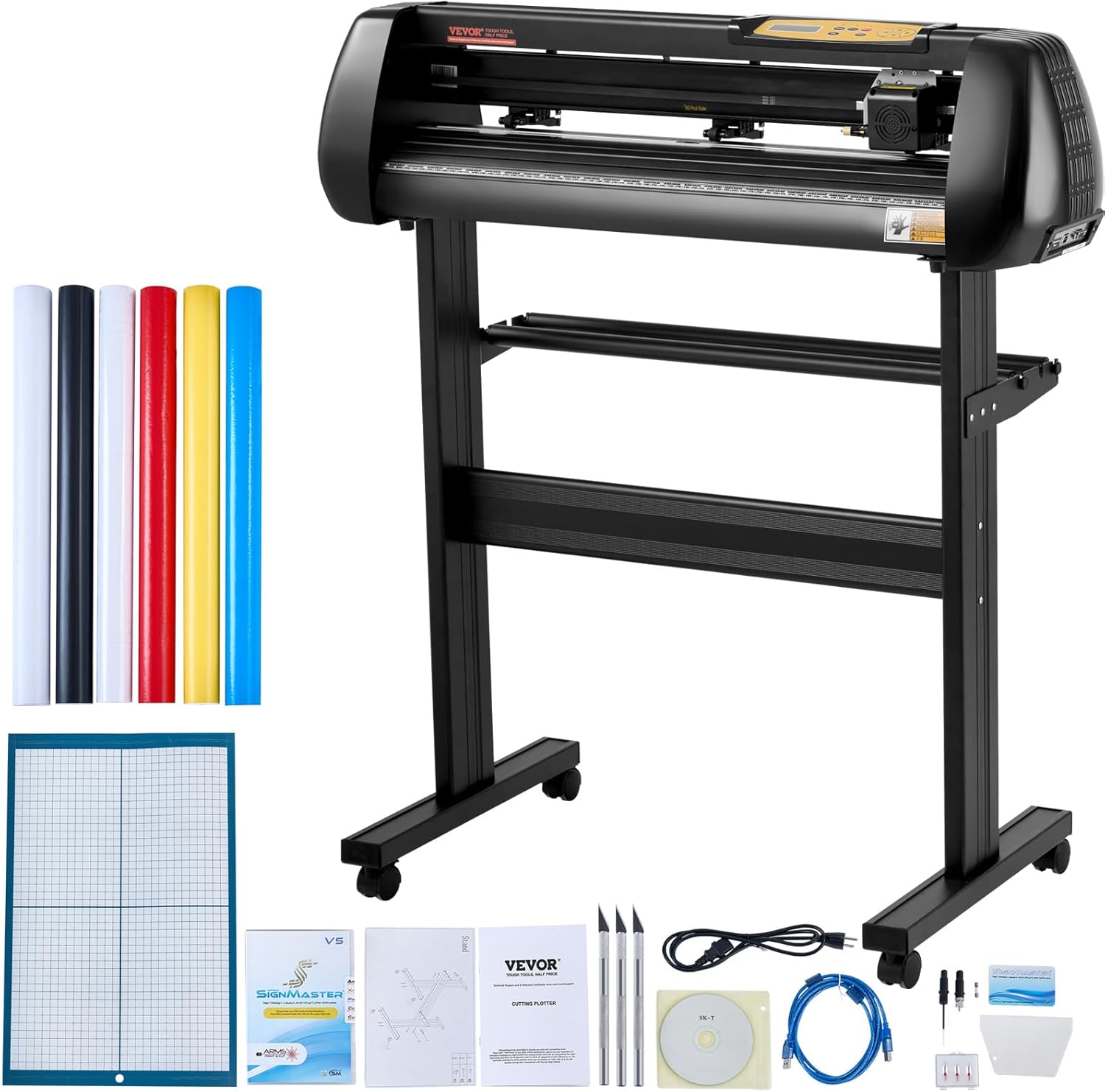Let me tell you about the Thanksgiving I tried roasting a 20-pound turkey in my standard 9×13 pan.
It didn’t fit. Obviously.
I ended up hacking off the legs just to cram it in, then watched helplessly as turkey juice overflowed onto my oven floor. The smoke alarm went off twice. My kitchen smelled like burned poultry fat for a week.
That’s when I finally bought a proper turkey roaster.
A good roaster gives your bird room to breathe, catches all the drippings, and delivers even heat for crispy skin and juicy meat. Whether you’re cooking for Thanksgiving, Christmas, or just because you love roast turkey, the right roaster makes everything easier.
I’ve tested seven different roasters over the past few years. Some were disasters. Others changed my holiday cooking forever.
Let me show you which ones actually work.
Quick Pick: Our #1 Recommendation
Granite Ware 18-Inch Covered Oval Roaster
This is the roaster sitting in my cabinet right now. It’s handled everything from 22-pound turkeys to massive pot roasts.
The covered design self-bastes your turkey while it cooks. The carbon steel heats evenly. The non-stick porcelain surface cleans up in minutes. And at around $35-45, it won’t wreck your budget.
I’ve used mine for four Thanksgivings straight. Still looks new.
4 Best Turkey Roasters (Tested & Reviewed)
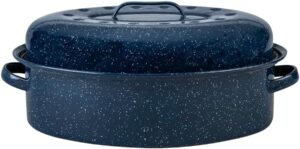
Best For: Home cooks who want foolproof results without fussing
This roaster makes you look like you know what you’re doing, even if it’s your first time cooking a turkey.
The lid traps steam and moisture, so your turkey bastes itself. You don’t need to open the oven every 30 minutes with a baster. Just let it cook.
Specs:
- Fits turkeys up to 22 pounds
- Carbon steel with porcelain enamel coating
- Includes flat rack and domed lid
Pros:
- Self-basting lid keeps turkey moist automatically
- Non-stick surface makes cleanup ridiculously easy
- Works on stovetop for making gravy directly in the pan
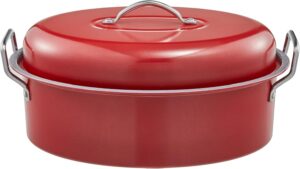
Best For: First-time turkey cooks who need everything included
This is the complete package. You get the pan, a sturdy V-rack, lifting forks for safely moving your turkey, and even a basting brush.
I recommended this to my neighbor who’d never cooked a turkey before. She texted me after Thanksgiving: “Why didn’t anyone tell me it was this easy?” The included tools made her feel confident instead of overwhelmed.
Specs:
- 18-inch stainless steel construction
- Includes V-rack, turkey lifters, and basting brush
- Handles turkeys up to 25 pounds
Pros:
- Complete set means no scrambling for extra tools
- Deep sides (3.5 inches) prevent spills
- Dishwasher safe for easy cleanup
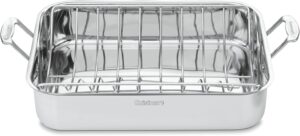
Best For: Cooks who want restaurant-quality browning and crispy skin
If you’re obsessed with crispy, golden-brown turkey skin, this is your pan. No lid means maximum air circulation and serious browning.
I use this when I’m cooking for guests who care about presentation. The stainless steel looks professional, and the turkey comes out magazine-worthy every time.
Specs:
- Heavy-gauge stainless steel construction
- 16-inch pan fits turkeys up to 20 pounds
- U-shaped nonstick rack lifts turkey for even cooking
Pros:
- Superior browning compared to covered roasters
- Rack keeps turkey elevated above drippings
- Dishwasher safe and built to last decades
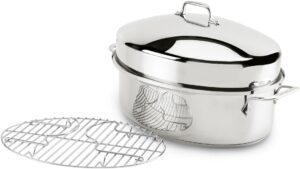
Best For: Serious cooks who want heirloom-quality equipment
This is the roaster you buy once and use for the next 30 years. It’s expensive. But it’s also the best roaster I’ve ever used.
The tri-ply stainless steel distributes heat like magic. No hot spots. No scorched corners. Just perfect, even cooking from edge to center.
Specs:
- 16-inch roaster with 3-ply stainless steel construction
- Handles turkeys up to 20 pounds
- Includes stainless steel V-rack
Pros:
- Commercial-grade construction that lasts forever
- Safe for stovetop, oven, and broiler
- Makes the best pan gravy because of superior heat distribution
What to Consider When Buying a Turkey Roaster
Size Matters More Than You Think
Here’s the rule: your roaster should be 2-3 inches larger than your turkey on all sides. Cramming a turkey into a too-small pan blocks air circulation and gives you pale, soggy skin.
For a 15-pound turkey, you need at least a 16-inch roaster. For 20+ pounds, go with 18 inches minimum.
Measure your oven too. I’ve seen roasters that technically fit turkeys but don’t fit ovens. Check your oven’s interior dimensions before buying.
Material Changes Everything
Stainless steel heats evenly and lasts forever but costs more. It’s also heavier and harder to clean.
Carbon steel with enamel coating is the sweet spot. Good heat distribution, non-stick surface, and reasonable price.
Aluminum (including disposable pans) is lightweight and cheap but conducts heat unevenly. You might get hot spots.
Tri-ply construction (stainless steel with an aluminum core) gives you the best of both worlds—even heating and durability.
Covered vs. Uncovered
Covered roasters trap moisture and essentially steam-roast your turkey. You get juicy meat but less crispy skin.
Uncovered roasters give you maximum browning and crispy skin but require more attention. You’ll need to baste and possibly tent with foil.
I use covered roasters for laid-back family dinners. Uncovered for impressive holiday spreads.
The Rack Is Essential
Never skip the rack. It lifts your turkey above the drippings so air circulates underneath. This means even cooking and skin that crisps on all sides, not just the top.
V-shaped racks hold the turkey more securely than flat racks. But flat racks work fine if you’re careful transferring the bird.
Handles Need to Be Sturdy
You’re lifting a 20-pound turkey plus a heavy roasting pan out of a 400°F oven. Flimsy handles are legitimately dangerous.
Look for riveted handles or handles that extend far enough to grab with thick oven mitts. I learned this after nearly dropping a turkey because I couldn’t grip the tiny handles properly.
Easy Cleanup Saves Your Sanity
Non-stick coatings make cleanup about 10 times easier. Turkey drippings are sticky and greasy. Without non-stick, you’re scrubbing for 20 minutes.
Stainless steel isn’t non-stick, but it’s dishwasher safe if you have a commercial-sized machine. Most home dishwashers can’t fit large roasters.
Honestly? I hand-wash everything regardless. It’s easier than trying to Tetris a roaster into my dishwasher.
Conclusion: The Right Roaster Makes Thanksgiving Actually Enjoyable
Here’s what nobody tells you about roasting turkey: the pan matters as much as the recipe.
You can follow the perfect technique, brine for 24 hours, and use fresh herbs. But if your turkey is swimming in drippings in a too-small pan, you’re getting soggy skin and uneven cooking.
Since switching to the Granite Ware covered roaster, my Thanksgiving stress has dropped by half. The turkey cooks itself. The drippings stay contained. And cleanup takes maybe five minutes.
If you’re cooking your first turkey or just tired of mediocre results, start with the Granite Ware. It’s forgiving, affordable, and delivers consistent results. Or grab the BRONYPRO set if you want all the tools included from day one.
If you’re after professional-level browning, grab the Cuisinart or All-Clad. If you’re traveling or just hate cleanup, Reynolds disposable pans are legitimately useful.
Your turkey deserves better than a cramped pan and crossed fingers. Get the right roaster. You’ll taste the difference.
Frequently Asked Questions
What size roasting pan do I need for my turkey?
Use this quick guide: 12-14 pound turkey needs a 14-inch pan. 15-18 pounds needs 16 inches. 20+ pounds needs 18 inches minimum. Always leave 2-3 inches of space around the turkey for proper air circulation.
Do I really need a rack in my roasting pan?
Yes. The rack lifts your turkey above the drippings so heat circulates underneath. Without it, the bottom stays pale and gets soggy. If your roaster doesn’t include a rack, you can make one from crumpled aluminum foil or buy one separately.
Can I use my roasting pan on the stovetop?
It depends on the material. Stainless steel, carbon steel, and enameled roasters usually work on stovetops for making gravy. Disposable aluminum pans don’t. Check your roaster’s specifications before putting it on a burner.
Should I use a covered or uncovered roaster?
Covered roasters keep turkey moist but give you softer skin. Uncovered roasters create crispy skin but require more basting. I use covered roasters for weeknight dinners and uncovered for holidays when I want impressive presentation.
How do I clean a roasting pan with burnt drippings?
Fill the pan with hot water and dish soap. Let it soak for 30 minutes. For stubborn spots, make a paste from baking soda and water, scrub with a non-scratch sponge. For really stuck-on bits, simmer water in the pan on the stovetop to loosen everything.
Can I cook other things besides turkey in a roasting pan?
Absolutely! I use mine for pot roasts, whole chickens, ham, prime rib, and even large batches of roasted vegetables. A good roaster is one of the most versatile pans in your kitchen.
Are disposable roasting pans safe for large turkeys?
Heavy-duty disposable pans can handle turkeys up to 18-20 pounds safely. But place the disposable pan on a sturdy baking sheet when transferring it in and out of the oven. The aluminum can buckle under the weight, which is messy and dangerous.
What’s the difference between a roasting pan and a baking dish?
Roasting pans have higher sides (3-4 inches) to contain drippings and are built to handle high heat. Baking dishes are shallower and not designed for heavy proteins. You can technically roast in a baking dish, but you’ll risk overflow and uneven cooking.

